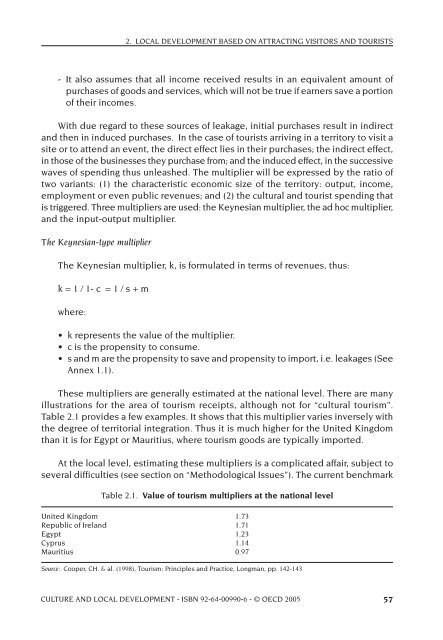OECD Culture and Local Development.pdf - PACA
OECD Culture and Local Development.pdf - PACA
OECD Culture and Local Development.pdf - PACA
You also want an ePaper? Increase the reach of your titles
YUMPU automatically turns print PDFs into web optimized ePapers that Google loves.
2. LOCAL DEVELOPMENT BASED ON ATTRACTING VISITORS AND TOURISTS<br />
- It also assumes that all income received results in an equivalent amount of<br />
purchases of goods <strong>and</strong> services, which will not be true if earners save a portion<br />
of their incomes.<br />
With due regard to these sources of leakage, initial purchases result in indirect<br />
<strong>and</strong> then in induced purchases. In the case of tourists arriving in a territory to visit a<br />
site or to attend an event, the direct effect lies in their purchases; the indirect effect,<br />
in those of the businesses they purchase from; <strong>and</strong> the induced effect, in the successive<br />
waves of spending thus unleashed. The multiplier will be expressed by the ratio of<br />
two variants: (1) the characteristic economic size of the territory: output, income,<br />
employment or even public revenues; <strong>and</strong> (2) the cultural <strong>and</strong> tourist spending that<br />
is triggered. Three multipliers are used: the Keynesian multiplier, the ad hoc multiplier,<br />
<strong>and</strong> the input-output multiplier.<br />
The Keynesian-type multiplier<br />
The Keynesian multiplier, k, is formulated in terms of revenues, thus:<br />
k = 1 / 1- c = 1 / s + m<br />
where:<br />
• k represents the value of the multiplier.<br />
• c is the propensity to consume.<br />
• s <strong>and</strong> m are the propensity to save <strong>and</strong> propensity to import, i.e. leakages (See<br />
Annex 1.1).<br />
These multipliers are generally estimated at the national level. There are many<br />
illustrations for the area of tourism receipts, although not for “cultural tourism”.<br />
Table 2.1 provides a few examples. It shows that this multiplier varies inversely with<br />
the degree of territorial integration. Thus it is much higher for the United Kingdom<br />
than it is for Egypt or Mauritius, where tourism goods are typically imported.<br />
At the local level, estimating these multipliers is a complicated affair, subject to<br />
several difficulties (see section on “Methodological Issues”). The current benchmark<br />
Table 2.1. Value of tourism multipliers at the national level<br />
United Kingdom 1.73<br />
Republic of Irel<strong>and</strong> 1.71<br />
Egypt 1.23<br />
Cyprus 1.14<br />
Mauritius 0.97<br />
Source: Cooper, CH. & al. (1998), Tourism: Principles <strong>and</strong> Practice, Longman, pp. 142-143<br />
CULTURE AND LOCAL DEVELOPMENT - ISBN 92-64-00990-6 - © <strong>OECD</strong> 2005 57














